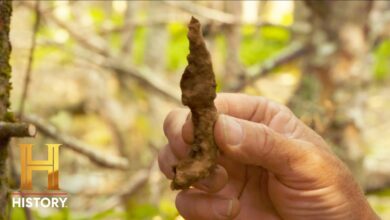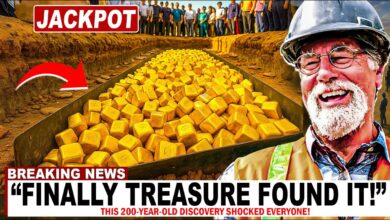The Curse of Oak Island: MAJOR FIND! Antique 18th Century Artifacts Unearthed (Season 8) | History
The Curse of Oak Island: MAJOR FIND! Antique 18th Century Artifacts Unearthed (Season 8) | History

Back in the uplands near the swamp, hey Rick.
Hey Rick Laguna, along with Dr. Aaron Taylor, Miriam Ammerald, and Alex Laguna, continue their own search for valuable clues along the stone pathway.
As this path appears to turn to the upland, we’re finding an incredible amount of artifacts.
What’s that?
So, I don’t know what to make of it. Is this the centralized location for the build of the stone path?
I don’t know, the more we look, the more we find.
That might be stone, that’s not.
No, that’s brick fragment. This is nice.
That’s a fragment of a pipe bowl. Mm-hmm.
Clean it up, we maybe get a maker’s mark on it and then we’ll be able to tell where it was made and when it was good.
That’s annular wear. That’s the early stuff, quite early 1760s.
Okay, I’ll bag this up.
Okay, great.
I’m just gonna go check on those guys.
All right, thanks Rick.
Okie doke.
Working with Aaron and Miriam, it’s like a little mini treasure hunt.
You know, you’re scraping away with the trowel and all of a sudden, they’re in front of you as a little surprise, a little… again, a little piece of hopefully connective tissue.
So, it’s somewhat intoxicating and addictive.
[Music]
Well, that’s interesting.
I don’t know what that is.
I’d like to see three people hurt at work.
Hey Rick, any breakthroughs?
So here’s what’s down there.
There was one more find, which I found interesting.
Sweet Jesus.
[Music]
It’s really nice. It’s a base, probably a plate.
There you go, just looking at it now, it looks like cream ware.
Creamware comes in in 1763, the British bring it in when they arrive.
It might be yellow ware, which is a little later, just because all the pieces we’ve been finding are from that period.
I think this is a cream ware, but you seldom find a nice base intact like that.
First produced around the 1740s in Staffordshire, England, creamware is a refined lead-glazed earthenware named for its yellowish-white, cream-like color.
Could this discovery be an important clue to help identify who made the cobblestone pathway?
If so, might it also be connected to the pine tar kiln located on nearby lot 15, which blacksmith expert Carmen Legge believes was a British design and which archaeologist Laird Niven believes may have been used for the continuous burning of materials in the construction of the original Money Pit?
Well, I’ve been waiting all summer for a sweet Jesus moment and… sweet Jesus.
That is a nice base. Now let’s find the rest of it.
But if that’s creamware, that’s a really nice early piece.
Well, I’ve got about that much of a shelf to do. That’s still a work in progress, and as you see, there’s things to be found.
Keeps giving.
Yeah, okay, I’ll back these up.
Okay, cool.
All right, yep, I shall return.








